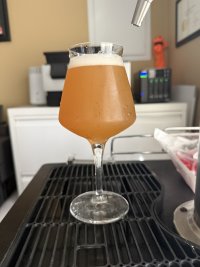So, I had scored an IPA bundle from Northern Brewer. It was 3 extract recipes. Unfortunately, the recipe kits were made with LME (i am thinking darker / gray colored NEIPA). I had DME on hand that I substituted. Here is the recipe (5 gallons of beer - kegged)
1 pound Flaked Oats (steeped at 155 degrees for 30 minutes)
6 pounds Pilsen Light DME (boiled for 20 minutes)
1 pound Bavarian Wheat DME (boiled for 20 minutes)
2 oz. Mosaic (last 5 minutes)
1 oz. Citra (last 5 minutes)
2 oz. Mosaic (dry hop for 5 days)
2 oz. Citra (dry hop for 5 days)
1 pack Lallemand New England dry yeast
2 vials of Brewzyme-D (one at yeast pitching and one at dry hopping)
Fermented at 70 (plus/minus) for 14 days, dry hop for 5 (in primary) and transferred to purged Corny keg and pressurized w/ 12 psi for one week)
The beer came out great! But, I wanted to know if there was a steeping grain that I could add that would improve the color to be more of that ‘orange’ color associated with most NEIPA. I do think the color is good, but could it be better?
1 pound Flaked Oats (steeped at 155 degrees for 30 minutes)
6 pounds Pilsen Light DME (boiled for 20 minutes)
1 pound Bavarian Wheat DME (boiled for 20 minutes)
2 oz. Mosaic (last 5 minutes)
1 oz. Citra (last 5 minutes)
2 oz. Mosaic (dry hop for 5 days)
2 oz. Citra (dry hop for 5 days)
1 pack Lallemand New England dry yeast
2 vials of Brewzyme-D (one at yeast pitching and one at dry hopping)
Fermented at 70 (plus/minus) for 14 days, dry hop for 5 (in primary) and transferred to purged Corny keg and pressurized w/ 12 psi for one week)
The beer came out great! But, I wanted to know if there was a steeping grain that I could add that would improve the color to be more of that ‘orange’ color associated with most NEIPA. I do think the color is good, but could it be better?

















![Craft A Brew - Safale S-04 Dry Yeast - Fermentis - English Ale Dry Yeast - For English and American Ales and Hard Apple Ciders - Ingredients for Home Brewing - Beer Making Supplies - [1 Pack]](https://m.media-amazon.com/images/I/41fVGNh6JfL._SL500_.jpg)








































